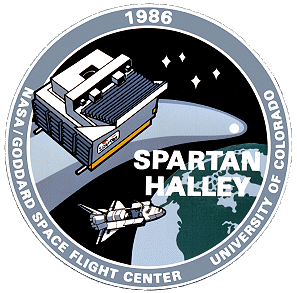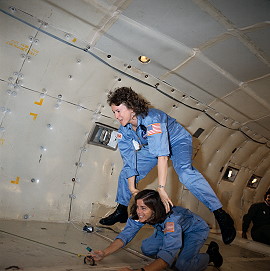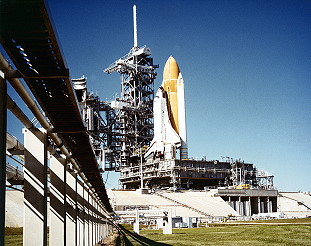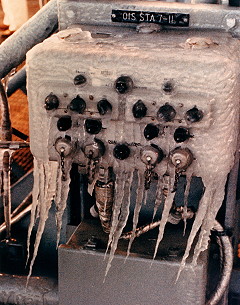Launch failures
![]()
STS-51LChallenger (10)25th Space Shuttle missionUSA |
 |
 |
 |
||
![]()
Launch and landing data
walkout photo |
 |
||||||||||||||||
alternative crew photo |
Crew
| No. | Surname | Given names | Position | Duration | |
| 1 | Scobee | Francis Richard "Dick" | CDR | 73sec | |
| 2 | Smith | Michael John | PLT | 73sec | |
| 3 | Onizuka | Ellison Shoji | MS-1, EV-2 | 73sec | |
| 4 | Resnik | Judith Arlene "J.R." | MS-2, RMS, FE | 73sec | |
| 5 | McNair | Ronald Erwin | MS-3, EV-1 | 73sec | |
| 6 | McAuliffe | Sharon Christa Corrigan | PS-1 | 73sec | |
| 7 | Jarvis | Gregory Bruce | PS-2 | 73sec |
Crew seating arrangement
|
 |
|||||||||||||||||
Backup Crew
| No. | Surname | Given names | Position | |
| 6 | Morgan | Barbara Radding "Barby" | PS-1 | |
| 7 | Butterworth | Louis William | PS-2 |
Hardware
| Orbiter : | OV-099 (10.) |
| SSME (1 / 2 / 3): | 2023 (5.) / 2020 (6.) / 2021 (6.) |
| SRB: | BI-026 |
| ET: | ET-26 (LWT-19) |
| OMS Pod: | Left Pod 02 - LV 01 (7.) / Right Pod 02 - RV 01 (7.) |
| FWD RCS Pod: | FRC 9 (10.) |
| RMS: | 302 (5.) |
| EMU: | EMU Nr. 1080 (PLSS Nr. 1007) / EMU Nr. 1075 (PLSS Nr. 1012) |
Flight
|
Launch from Cape Canaveral (KSC). Main objectives for the mission STS-51L were: - to fly a high school teacher as America's first private citizen to fly aboard the Shuttle in NASA's Space Flight Participant Program, - deployment of TDRS-B to become TDRS-1 in geosynchronous orbit to provide high-capacity communications and data links between Earth and the Shuttle, as well as other spacecraft and launch vehicles, - the scientific objective of SPARTAN-Halley was to measure the ultraviolet spectrum of comet Halley as the comet approaches the point of its orbit that will be closest to the sun. The Tracking and Data Relay Satellite (TDRS-B) should be the second TDRSS advanced communications spacecraft to be launched from the orbiter Challenger. The first was launched during Challenger's maiden flight STS-6 in April 1983. TDRS-1 was at this time in geosynchronous orbit over the Atlantic Ocean just east of Brazil (41 degrees west longitude). It initially failed to reach its desired orbit following successful Shuttle deployment because of booster rocket failure. Following its deployment from the orbiter, TDRS-B was scheduled to undergo a series of tests prior to being moved to its operational geosynchronous position over the Pacific Ocean south of Hawaii (171 degrees W. longitude). TDRS-B was scheduled to be deployed from the orbiter approximately 10 hours after launch. Transfer to geosynchronous orbit was planned to provide by the solid propellant Boeing/U.S. Air Force Inertial Upper Stage (IUS). Separation from the IUS should occur approximately 17 hours after launch. The concept of using advanced communication satellites was developed following studies in the early 1970s which showed that a system of communication satellites operated from a single ground terminal could support Space Shuttle and other low Earth-orbit space missions more effectively than a world-wide network of ground stations. The satellite consisted of two modules. The equipment module housed the subsystems that operate the satellite. The telecommunications payload module had electronic equipment for linking the user spacecraft with the ground terminal. The spacecraft had seven antennas. For the SPARTAN-Halley mission, NASA's Goddard Space Flight Center and the University of Colorado's laboratory for Atmospheric and Space Physics (LASP) had recycled several instruments and designs to produce a low-cost, high-yield spacecraft to watch Halley's Comet when it is too close to the sun for other observatories to do so. Two spectrometers, derived from backups for a Mariner 9 instrument which studied the Martian atmosphere in 1971, have been rebuilt to survey Halley's Comet in ultraviolet light from 128 to 340 nanometers (nm) wavelength, stopping just above the human eye's limit of about 400 nm. Each spectrometer should use the Ebert-Fastie design: an off-axis reflector telescope, with magnesium fluoride coatings to enhance transmission which focuses light from Halley, via s spherical mirror and a spectral grating, on a coded anode converter with 1,024 detectors in a straight line. The grating is ruled at 2,400 lines per millimeter. With Halley as little as 10 degrees away from the sun, two sets of baffles should be used to reduce stray light. An internal set is part of the Mariner design. A new external set serves both instruments. It has two knife-edge baffles 38.5 inches (98 centimeters) away from the spectrometer entrances, and 20 secondary baffles to stop earthlight. Together, the two baffle sets reduce stray light by a factor of a trillion. It is this system that will make it possible for SPARTAN-Halley to observe the comet while so close to the sun. In addition, internal filters reduce solar Lyman-alpha light (121.6 nm), scattered by the Earth's hydrogen corona, which would saturate the instruments. Two film cameras, boresighted with the spectrometers, were scheduled to photograph Halley to assure pointing accuracy in post-flight analysis and to match changes in the tail with spectral changes. The 35 mm Nikon F3 cameras had 105 mm and 135 mm lenses and were loaded with 65-frame rolls of QX-851 thin-base color film. The cameras should capture large-scale activity such as the separation angle between the dust and ion tails, bursts from the nucleus, and asymmetries in the shape of the coma. The whole instrument package was mounted on an aluminum optical bench - 35 by 37 inches (89 by 95 centimeters) and weighing 175 lb. (79.4 kg) - attached to the SPARTAN carrier. This should provide a clean interface with the carrier and aligns the spectrometers with the SPARTAN attitude control sensors. A 15-inch-high (38 centimeters) housed covers the spectrometers and the cameras. The planned on-orbit operations were: After a predeployment health check of SPARTAN voltages and currents, the Shuttle robot arm should pick up the spacecraft and hold it over the side. Upon release, SPARTAN should perform a 90-second "pirouette" to confirm that it is working and the Shuttle should back away to at least five miles so light reflected from the Shuttle does not confuse SPARTAN's sensors. After two orbits of preparation, the 40-hour science mission should begin. A backup timer should ensure that the spectrometer doors open 70 minutes after release. SPARTAN-Halley should conduct 20 orbits of science observations interspersed with five orbits of attitude control updates. A typical science orbit was planned to start with four 100-second calibration scans of Earth's atmosphere, followed by a 900-second tail scan. Observing should be interrupted for 15 minutes of pointing updates and housekeeping. It then should resume with four 200-second scans of the coma, followed by sunset and four coma scans while the sun is occulted. At the end of the mission SPARTAN-Halley was scheduled to be retrieved by the Shuttle robot arm and placed in the payload bay. The SPARTAN-Halley 200 carrier measured 52 by 43 by 51 in. (132 by 109 by 129 centimeters) and weighed 2,250 lb. (1,021 kg) without payload. The attitude control system and other components should use elements from the sounding rocket program. All data should be stored on a Bell & Howell MARS 1400 recorder; 500 megabytes of storage was available to the experimenter. The spacecraft had its place on the SPARTAN Flight Support Structure and was held in place by a release and-engage mechanism. Teacher observer Christa McAuliffe was scheduled to conduct two lessons on Flight Day 6 of the mission. The first lesson entitled "The Ultimate Field Trip" should allow students to compare daily life on the Shuttle with that on Earth. Conducting a tour of the Shuttle for viewers, Christa McAuliffe wanted to explain crewmembers' roles, show the location of computers and controls and describe experiments being conducted on the mission. She also wanted to demonstrate how daily life in space is different from that on Earth in the preparation of food, movement, exercise, personal hygiene, sleep and the use of leisure time. The second lesson, "Where We've Been, Where We're Going, Why?" should help the audience understand why people use and explore space by demonstrating the advantages of manufacturing in the microgravity environment, highlighting technological advances that evolve from the space program and projecting the future of humans in space. During the ascent phase, 73 seconds after liftoff, the vehicle experienced a catastrophic structural failure resulting in the loss of crew and vehicle. The Rogers Commission later determined the cause of the accident to have been the failure of the primary and secondary (backup) O-ring seals on Challenger's right Solid Rocket Booster. The failure of these seals allowed a flamethrower-like flare to impinge upon one of two aft SRB attach struts, which eventually failed, freeing the booster to pivot about its remaining attachment points. The forward part of the booster cylinder struck the external tank inter-tank area, leading to a structural failure of the ET - the core structural component of the entire stack. A rapid burning of liberated propellants ensued. With the structural "backbone" of the stack compromised and breaking up, the SRBs flew off on their own, as did the orbiter, which rapidly disintegrated due to overwhelming aerodynamic forces. The launch had been approved despite a predicted ambient temperature of 26 °F (-3 °C), well below the qualification limit of major components such as the SRBs, which had been certified for use only at temperatures above 40 °F (4 °C). Evidence found in the remnants of the crew cabin showed that several of the emergency air supplies (PEAPs) carried by the astronauts had been manually activated, suggesting that forces experienced inside the cabin during breakup of the orbiter were not inherently fatal, and that at least three crew members were alive and capable of conscious action for some period of time following vehicle breakup. "Tracking reported that the vehicle had exploded and impacted the water in an area approximately located at 28.64 degrees north, 80.28 degrees west", Mission Control, Houston. The mission ended in disaster with the destruction of Challenger seventy-three seconds after lift-off and the death of all seven crewmembers. Divers from the USS Preserver located the crew cabin on the ocean floor on March 07, 1986. A dive the following day confirmed that the remains of the crew were inside. At least some of the astronauts were likely alive and briefly conscious after the breakup, as three of the four recovered Personal Egress Air Packs (PEAPs) on the flight deck were found to have been activated. Investigators found their remaining unused air supply roughly consistent with the expected consumption during the 2 minute 45 second post-breakup trajectory. Whether the astronauts remained conscious long after the breakup is unknown, and largely depends on whether the detached crew cabin maintained pressure integrity. If it did not, the time of useful consciousness at that altitude is just a few seconds; the PEAPs supplied only unpressurized air, and hence would not have helped the crew to retain consciousness. If, on the other hand, the cabin was not depressurized or only slowly depressurizing, the astronauts may have been conscious and cognizant for the entire fall until impact. Due to the Challenger explosion the Space Shuttle fleet was grounded until STS-26 in September 1988. |
Photos / Graphics
 |
 |
 |
 |
 |
 |
 |
| © |  |
Last update on March 29, 2020.  |
 |